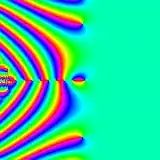I'm learning special functions by programming them, largely for fun. This post discussed why or how $\zeta(-1)=-1/12$, while my interest is how to numerically evaluate the zeta function at -1 and other points on $\mathbb{R}$.
Corresponding to the definition of Riemann zeta function $$ \zeta(z)= \sum_{n=1}^\infty n^{-z} $$ where $n^{a+bi}=n^a[\cos(b \ln n)+i\sin (b \ln n)]$, my codes read:
public static double[] R_powerZ(double n, double[] v){
double a=v[0];
double b=v[1];
double theta= b* Math.log(n);
double[] c={ Math.cos(theta), Math.sin(theta)};
return M.scale(c, Math.pow(n, a));
}
public static double[] zeta(double[] tau, int interation) {
double[] re = new double[2];
for (int i = 1; i <= interation; i++) {
double[] v = R_powerZ(i, M.scale( tau ,-1));
M._add(re, v);
}
return re;
}
Let $z=-1$ and $n=50$, the numerical result is (1275,0). I can see that the value will increase when n increases, does it means that the series is divergent when $z=-1$?. I also tried $\zeta(-0.99999)=(1274.9563...,0)$ which indicates that the function is continuous around -1.
Such numerical evaluation is far from the result of $\zeta(-1)=1+2+3+\cdots=-1/12$. Further, it's crazy to get a negative value from this summation!
I read this old post. Partially convinced by the proof there, my question is: is there a constructive way (by programming, by literal summation as the definition the zeta function) to calculate the value of $\zeta(z)$? If not, why we need a definition of $\sum_{n=1}^\infty n^{-z}$ at all?
Put it differently, how to get a good approximation of the zeta function by programming from scratch? This post did not explain any experiments (e.g. physical experiments or numeric algorithms) from which the value of the zeta function can be measured.
A convenient formula from wiki page is using Bernoulli number $$ \zeta(2n)= \frac{(-1)^{n+1} B_{2n}(2\pi)^{2n}}{2 (2n)!} $$ for positive even integer, and for nonpositive integer $$ \zeta(-n)= (-1)^n\frac{B_{n+1}}{n+1} $$ both give the "right" results of $\zeta(0)$ and $\zeta(-1)$. But how can the two formula comply with the original definition $\sum_{n=1}^\infty n^{-z}$?
Then I tried a 'globally' convergent series
$$
\zeta(z)=\frac{1}{1-2^{1-s}} \sum_{n=0}^\infty \frac{1}{2^{n+1}} \sum_{k=0}^n \binom{n}{k} \frac{-1^k}{(k+1)^s}
$$
from the wiki page, the corresponding codes yield this image (the color denotes the argument)

Hopefully I am on the right direction.